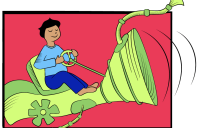Deltek Analyst Aila Altman reports.
With 46 million Supplemental Nutrition Assistance Program (SNAP) recipients nationwide – up from 27 million just four years ago – the U.S. Department of Agriculture (USDA) is contemplating how it can accommodate the ever-increasing need for food assistance in America. As part of the federal stimulus package, additional funding for SNAP was provided in 2009, but will come to an end in 2013.
In Washington D.C., the idea of turning SNAP into a state-run block grant program has been tossed around, but not without widespread objection. Additionally, prevention of fraud and abuse of SNAP is a common concern. With one in seven Americans receiving SNAP benefits, the government has little choice but to identify a solution or face increasing food insecurity rates throughout the country.
In June 2011, the House passed a plan to convert SNAP into a block grant program; however, apprehension was rampant. Under a block grant structure, states would likely struggle to accommodate increasing needs during times of economic strife or, as recently demonstrated, when dealing with the aftereffects of natural disasters. The risk that states may reallocate SNAP block grant funding to other state-operated programs also exists, particularly as states continue to struggle with budgetary constraints.
For the complete blog, go here.




Leave a Reply
You must be logged in to post a comment.